Camping the Easy Way: My new van- Fifi
By Joni Johnson
Last year, I wrote an article about what it was like to tent-camp as a solo woman. As you may remember, I had everything I needed including a pop-up bed that would be 20 inches off the ground and a little camping toilet for those middle of the night moments. But I kept thinking that as I grew older, putting up a tent by myself would become harder and if I were to do it, I probably wouldn’t do it for just one or two nights.

Fifi at Edenvale Winery in January
So in January, I just started looking for a small class B camper van. In addition to the ease of use, I figured a locked door wouldn’t be a bad thing. At first, I thought a cute little trailer would work, but I was quickly talked out of that because towing could be a problem. I had been in touch with a salesperson in Medford and we set up an appointment for a quick little look. He had four options available. I really liked Van number one. It was only 20 feet long, had a microwave, refrigerator, toilet (with a wet bath- which I will probably never use) air conditioning. A generator and a bed that I could leave set-up. I laughingly offered a low-ball figure but they amazingly took it (January Sales) and all of a sudden I was the owner of a used 2015 RoadTrek RV I immediately named Fifi.
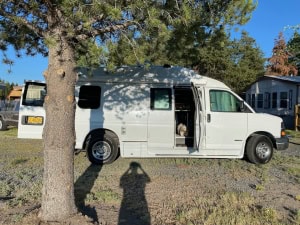
My spot at the Alpaca Farm
I took Fifi out for one night in January, checked out the problems and returned her to the dealership to fix. After that, I made a two week trip to Baja California to see the whales, and then I had a left reverse shoulder replacement for a lefty, which took me out of the game for a while. In June, I decided I would be strong enough to drive and lift objects, and off I went for a couple of two-day tryouts.

Joni and Starr at the Stonehenge replica near the Washington border
Finally, I planned a 15 day trip from Medford to Seattle via Bend and returning by the coast. This was all based on a four-day overnight stay at the Deschutes River State Recreation Area for a Peace Corps event. Everything went perfectly until the fire truck stormed by about three hours after I arrived. At first, we thought it was just a camper in distress. But more and more fire trucks went by and we realized there was an actual fire on the hill in front of us. All of a sudden, we were told to evacuate. There I was, with my dog in the van and everything packed up. But where to go? It was nine pm and I decided to head for Seattle, where my brother lived, on the already planned route. I got four miles away and found a nice little parking lot in the local Chevron station and called my brother. Within minutes he had found me a place at a local campground just across the bridge over the Columbia into Washington. Otherwise, I really didn’t know what to do because it was so dark and I wasn’t sure I could handle my new little rig on unknown, unlit roads at night. I think that my next choice would have been to curl up in the Chevron parking lot. Instead, my brother found the Peach Beach RV park, which was just lovely and right on the Columbia river. And, luckily, they had a spot available for three nights because of a cancellation. So I had a great time meeting all sorts of people, getting help on all sort of RV issues like keeping my generator going when the camp had a four hour power outage in the middle of over 100o weather.
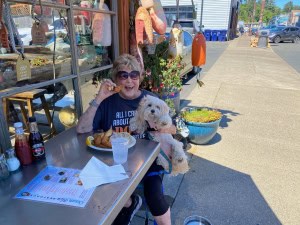
The continuation of the Oyster quest at Newport
The rest of the trip was lovely. Four days in Seattle with wonderful food and then moseying on down the coast from Tillamook to Waldport to Yachats and finally to Bandon before heading home. Mostly, I stayed in state campgrounds. A few times I stayed at wineries and cheese factories and alpaca farms through Harvest Hosts. My idea of traveling is eating out. And I managed to make no exception this time. Some people love to cook in their campground setting. I love to eat in restaurants. And so I made this an eating tour, checking out fried oysters and fish and chips for 200 miles. Driving via Portland and dealing with the traffic reminded me of Los Angeles with lots of stop and goes and slowdowns. I decided I would kiss the ground when I returned to Medford.
My final night was a non-camping extravaganza: a large pet-friendly king sized room at the Seven Feathers casino where I had prime rib and won money at the table before taking Starr out for her final walk of the day. I think I must have stayed in the shower long past the minutes typically allowed during a drought. It was heaven. But so was the rest of the trip.
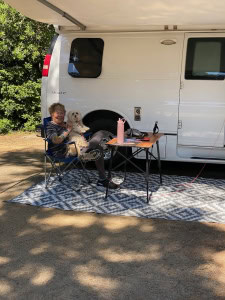
Hanging out at Bullards State Park
Some people think I am nuts for buying an RV and traveling on my own at my age. Other people have even used the word brave. A person I met at the RV spot in Washington wrote a blurb on her Facebook page about me. She, her husband and I became friends and plan to travel together. I would print what she said, but it would make me blush. But it was all about traveling on my own at my age. She did say, “P.S. If you ever see a lady and she is saying “I need a man” while trying to pump her own gas. Help that woman out because she is smart enough to know when to ask for help!” And I have to say that I do ask for help all the time.
I don’t see myself as brave at all. I just don’t see that I had a choice. It was either move forward and enjoy the rest of my life or stay stuck in the pain and loss of my loved-one. My husband passed away in May 2022. Before Tom got so sick, we traveled all the time. His illness and Covid brought that to an end for three years. But I realized that I only have so much time left, and I wanted to take advantage of it. Tom and I had traveled in a Class C motor home in the mid nineties. I loved the experience but really didn’t feel comfortable driving that large of a rig (24 ft) even then. He never wanted to buy an RV because of the work entailed. So we didn’t. But that was something I really wanted to do.
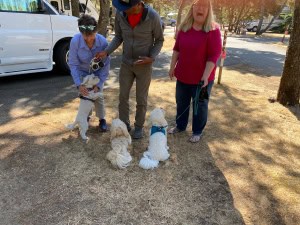
Meeting the dogs at Bullards State Park.
I see Fifi as giving me a sort of freedom I wouldn’t have without her. And she is a chance to really travel with my darling dog. She and I are a team. I don’t think of myself as alone when I am with her. If I were to rent a hotel room or an Air BnB, I would really be totally alone. You don’t come across that many people in terms of meaningful conversations, even with a dog, when you are traveling that way. But camping is different. There are people everywhere. You meet them walking your pup. You meet them because they are camped next to you. You meet them because you need help and many of them love being of service.
People ask me if I am afraid. I don’t think I have been. I lock my door at night. There are camp hosts in the state parks. And I haven’t heard of too many serial killers making reservations three months ahead so that they would have a place to camp. So RV camping gives me freedom, interesting people and adventure. I have no idea how many years more I have to be able to do this. I’m just keeping my fingers crossed!


 Apartment access: Only the Terrace has emergency electrical outlets in the apartments; in the Manor and the Plaza there are a limited number of outlets in the residential hallways. In the Plaza and the Terrace the emergency outlets are red; in the Manor all outlets are white, and the emergency outlets will need to be identified by testing. Use will have to be shared as there are far fewer outlets than apartments, and for things that can’t be charged or used in the hallways, extension cords or portable power supplies will be required (some Plaza apartment doors are more than 60 feet from the nearest emergency outlet). Anyone who might rely on a common area outlet should add a plug-in outlet multiplier to their emergency supplies. Battery packs may be a useful way for apartment residents to access emergency power, since they can be charged when convenient and used when needed.
Apartment access: Only the Terrace has emergency electrical outlets in the apartments; in the Manor and the Plaza there are a limited number of outlets in the residential hallways. In the Plaza and the Terrace the emergency outlets are red; in the Manor all outlets are white, and the emergency outlets will need to be identified by testing. Use will have to be shared as there are far fewer outlets than apartments, and for things that can’t be charged or used in the hallways, extension cords or portable power supplies will be required (some Plaza apartment doors are more than 60 feet from the nearest emergency outlet). Anyone who might rely on a common area outlet should add a plug-in outlet multiplier to their emergency supplies. Battery packs may be a useful way for apartment residents to access emergency power, since they can be charged when convenient and used when needed.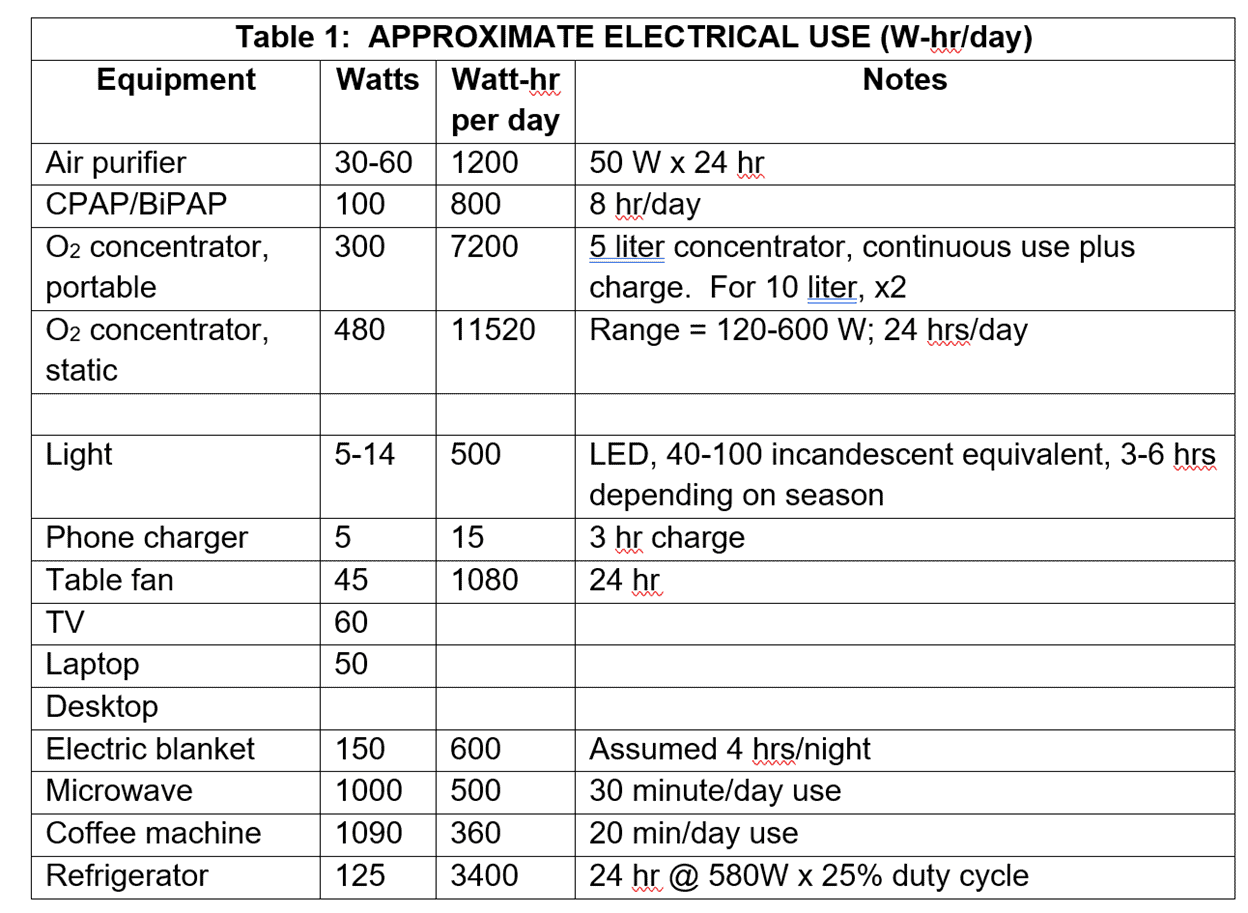
 An additional energy source that many people have is a car battery, which typically contains about 800 W-hrs of 12 volt direct current (DC). To access this you need a connecting cable with an appropriate plug or battery clamps on one end. For small items like a cell phone, a cigarette lighter-compatible USB port can be used (Figure 2). These are small and quite inexpensive. Virtually all modern cars already have USB ports. Powering AC devices from a car battery requires an inverter.
An additional energy source that many people have is a car battery, which typically contains about 800 W-hrs of 12 volt direct current (DC). To access this you need a connecting cable with an appropriate plug or battery clamps on one end. For small items like a cell phone, a cigarette lighter-compatible USB port can be used (Figure 2). These are small and quite inexpensive. Virtually all modern cars already have USB ports. Powering AC devices from a car battery requires an inverter.


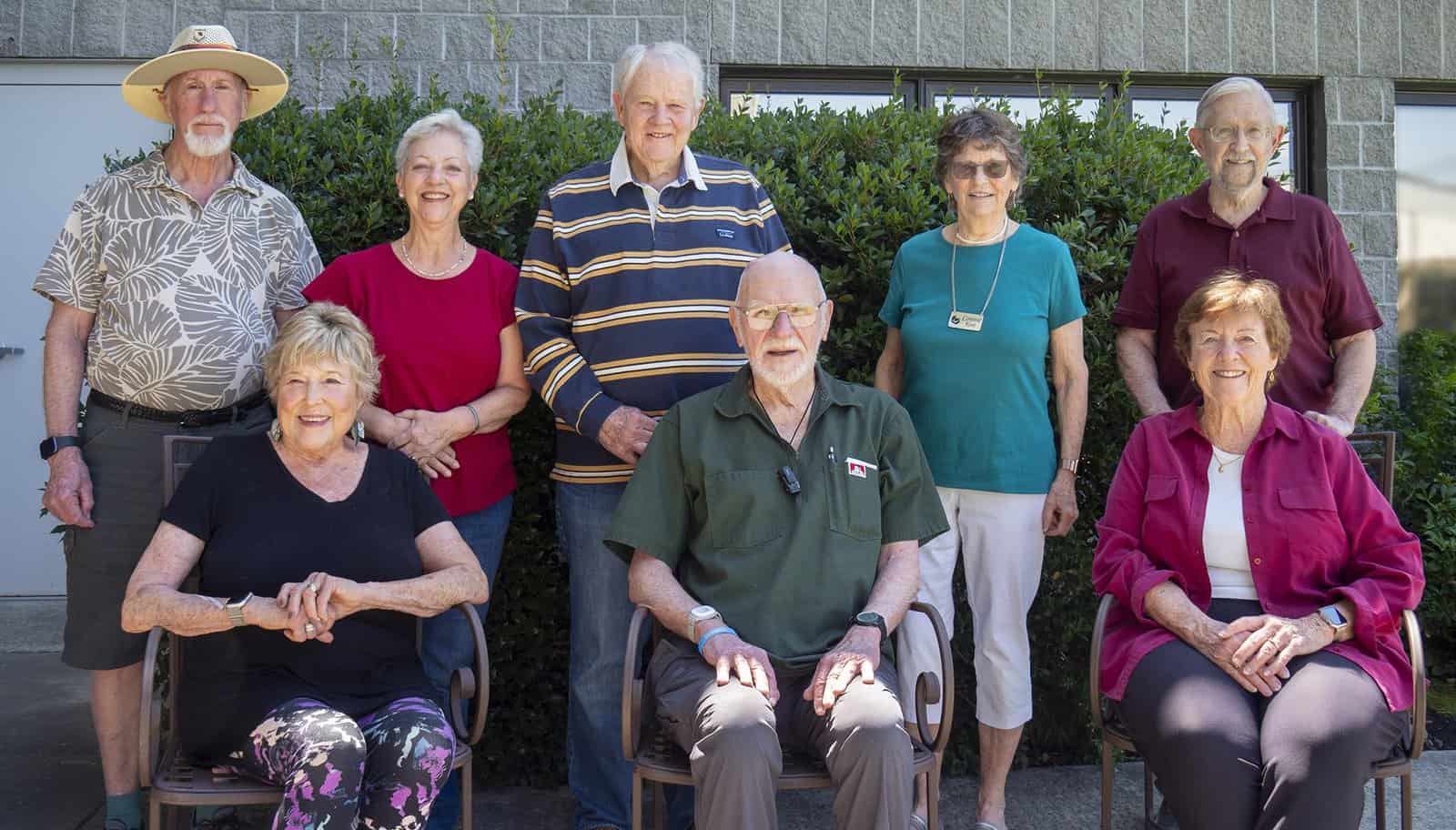

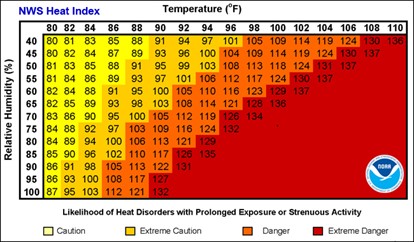
 Recently, the Supreme Court ruled against affirmative action in college admissions. In other words, race and ethnicity are no longer viable options for admission. Whether we like to admit it or not, the disadvantages won’t go away with the court’s ruling. I am the daughter of Mexican immigrants. And because of this, I was born into a life where I had disadvantages.
Recently, the Supreme Court ruled against affirmative action in college admissions. In other words, race and ethnicity are no longer viable options for admission. Whether we like to admit it or not, the disadvantages won’t go away with the court’s ruling. I am the daughter of Mexican immigrants. And because of this, I was born into a life where I had disadvantages.